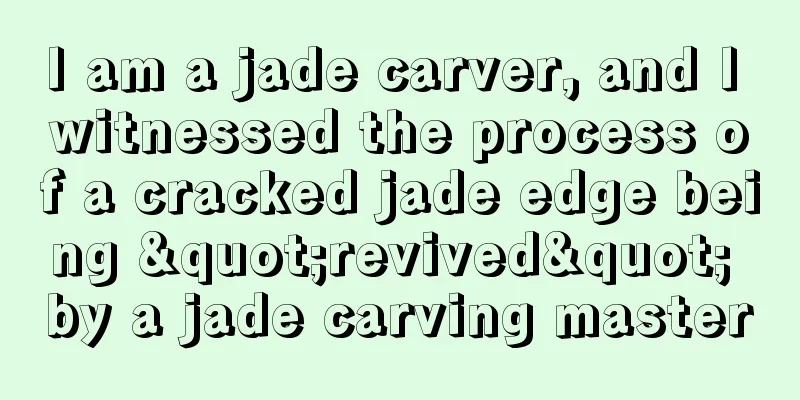Let’s take a look at the methods commonly used to identify the authenticity of jadeite. Which one have you used?

|
How to identify the authenticity of jadeite is something that many consumers have always wanted to learn. There are also many methods circulating among the people. Everyone hopes that there is a method that can help them tell the authenticity of jadeite at a glance. As a result, various identification methods began to circulate among the people, but can these methods really identify the authenticity of jade? Myth 1: Jade that feels cooler is real jade Many people in the community will tell you that if it is real jade, it will feel cool when you put it in your hand because jade has thermal conductivity. In fact, this is only somewhat useful for plastic glass, but for impersonating B-grade or C-grade jadeite, this method is totally unreliable. There is one more thing you must pay attention to! The feeling of coldness is just our sense of touch, which will change with the change of human hand temperature. Therefore, it is not sufficient to use coldness as the only basis for identification. Myth 2: If the hair is wrapped and burns continuously, it means it is real jadeite This is the method I hear most often. Many jade friends who have just accepted jade often ask me whether this method is reliable. The most widely circulated, magical and absurd statement among the people is that you wrap a strand of hair around jade and burn it with a lighter. If it burns off immediately, it is fake, and if it does not burn off, it is real. In fact, fire has inner flame and outer flame. The outer flame has a higher temperature. In addition, there is a big difference between loose and tight wrapping of hair. I know that someone will argue that jade has good thermal conductivity, so this method is scientific enough. But don’t forget, no matter how good the thermal conductivity of jade is, it cannot prevent the temperature of the external flame from burning your hair. If you don’t believe it, you can try it. Myth 3: Drip method There is a folk saying that if you drop a drop of water on jade, if it appears as round beads, then that is real jade. This is a phenomenon caused by the tension on the smooth surface of jade. It was possible to try it in the past, but in recent years the production technology of B-grade jade has become much more advanced. B-grade jade will undergo a second polishing, and the fakes that have been treated in this way will have acid-etched reticulation and acid-etched pits on the surface that cannot be seen even under a ten-fold magnifying glass, so the dripping method is no longer feasible now. Myth 4: Jade that can scratch glass is real jade Many merchants will tell consumers that jade is very hard and can scratch glass, otherwise it is fake! Let's analyze this. Glass is quartz. The Mohs hardness of quartz is 7, while the hardness of jade is 6.5-7. Glass is cryptocrystalline and has the same hardness in every direction. Jade is polycrystalline and its cleavage surface has different hardness, so jade may be damaged to a certain extent when it rubs against glass. And don’t forget that many quartz jades or other gems with higher hardness can scratch glass, so this is not a basis for identification. Myth 5: Jadeite with a crisp sound when knocked is real jadeite Using the sound of knocking jade to judge its authenticity sounds quite reliable. This is because the denser the crystal particles of jade, the more affected the propagation of sound waves when it is knocked. The smaller the sound waves, the crisper the sound. However, because B-grade jade has been acid-washed, its fiber structure is destroyed and becomes loose, so the sound it makes when knocked will be relatively dull. In fact, with the development and progress of counterfeiting technology, this method is no longer so scientific and reliable. The fillings of B-grade products are now also crisp after improvement. In addition, the knocking sound is actually related to the stone pattern. The knocking sound of A-grade jadeite with stone patterns will also be dull. Moreover, this method is not feasible for small beads, ring faces, inlays, etc. fcgc66 fcpf18 |
>>: Jade carving | "Hello, Li Huanying"
Recommend
You are still disdaining colorless jade, but others have already recognized its value.
Many people like jade with some color, and it wou...
What kind of jade can be considered Qingshui jade?
Speaking of jade, many female friends are not imm...
The Secret of Selecting Jadeite That Only Comes Once in a Century
Because jade is nourished by nature, its acquired...
How much do you know about choosing jade based on its six elements?
The six elements of jade •“Type, land, color, wor...
Do you like a Diamond Sutra pendant carved out of glutinous ice jadeite?
Jade carvings are often not simply carving patter...
What is the meaning of the jade peace locket? What styles are available?
The peace locket, known as "Huaigu" in ...
Why does inlay enhance the value and beauty of high-quality jadeite?
In addition to jade bracelets and loose stone pen...
Do you only know that jade will appreciate in value? Have you mastered these collection points?
With the development of the economy, people's...
Why is yellow and green jadeite so expensive? How to choose?
Yellow-green jadeite is a very rare variety. It h...
"Tennis Queen" Li Na appeared in London in a red dress and a million-dollar emerald, stunning the audience!
As jadeite becomes more and more popular among the...
How to choose jadeite lucky beans?
Jade wealth beans are also called blessing beans,...
A magical material priced at 4 million! What makes it so expensive?
When it comes to jade, whether it is finished pro...
Four types of jadeite with good meanings and versatile
Women who wear jade are like lotus flowers emergi...
Detailed explanation on how to identify jadeite ABC goods
First of all, we need to distinguish between A-gr...
This is how you choose a jade pendant so you don’t suffer a loss!
Many friends like jade. There are many types of p...









